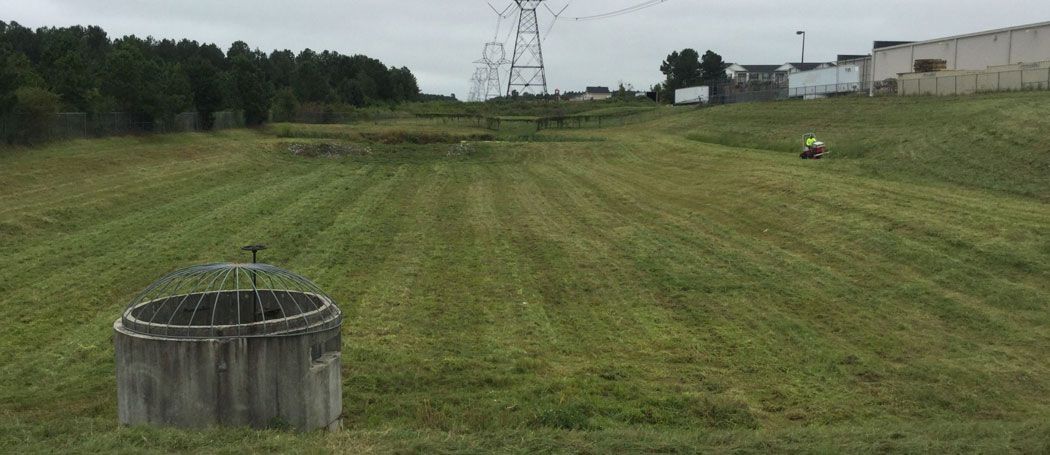Stormwater Maintenance Crews versus Landscapers
by Jason Abert, Vice President of Service Delivery
Have you ever wondered whether your stormwater control measures (SCMs) could benefit more from landscaping, or if you need to invest in professional stormwater maintenance? The outcome of a project for landscapers and stormwater maintenance crews may look similar, but the goals for each project are quite different. Landscapers aim to enhance the design of the site, protect the soil, water, and wildlife, reduce water use, and minimize mowing requirements[1]. Alternatively, a stormwater maintenance crew inspects and removes debris and sediment from SCMs, inspects stormwater assets for deficiencies, and maintains vegetated stormwater assets so that they are functional, aesthetically pleasing, and meet regulatory guidelines. A seasoned stormwater crew will know why each plant is there and how to care for each in the best way, leaving them visually pleasing for customers and guests[2]. As a business owner, it is important to make sure your business is compliant with any city and state requirements, while also maintaining the appearance of your investment for potential customers.
Landscapers aim to organize a site for maximum use and pleasure, as well as reduce the amount of required maintenance on the property; these objectives could compromise the efficiency and functionality of your stormwater assets. Landscape designers arrange plants and terrain to promote the environmental aspects surrounding residential or commercial properties, but important things can get overlooked by landscapers and this can lead to issues in and around your stormwater systems.
Relying on a landscaping crew to maintain your bioswales and detention basins can result in debris and sediment build up in your stormwater systems, which is one of the leading causes to the failure of your SCMs. Stormwater features can be appealing to the eye and have the capacity to store stormwater, but without proper maintenance your system may not work the way that it is designed. While performing maintenance on your business, landscaping crews often leave behind grass clippings and other debris that can obstruct stormwater conveyances meant to promote appropriate drainage and water quality. Without the knowledge that stormwater professionals have, build-up and debris that appears from mowing may get ignored and cause failure or violation to your stormwater control measure if not cleaned up and discarded of properly.
Some plants are intentionally used for stormwater runoff and are maintained differently than traditional landscaping species. Consider rush grasses, which grow best in moist soils. These grasses spread by seeds, therefore cutting or mowing the plant while young can kill or prevent future growth[3]. The plants used in and around stormwater swales and bioretention ponds grow best in moist, unmowed soils[3]. Their root systems help filter unwanted nutrients from stored stormwater. Without the knowledge that these species grow best under these conditions, a landscaper may mow the plant too short, and ruin its chance of persisting any further. A good maintenance crew will be aware of the species of plants present around their stormwater system, and how to best maintain them as stormwater assets.
Stormwater specialists incorporate native plants because of their adaptability and minimal maintenance requirements. Native species have adaptive advantages to their region and climate, which minimizes the amount of maintenance needed for these species of plants[4]. Whereas ornamentals are used in a lot of landscaping projects because they are aesthetically pleasing. These plants require more maintenance to help them thrive and make the conditions just right for them. Non-native plants often escape cultivation and thrive over native plants because of their lack of competition, leading to more maintenance needs in the long run to try and control their rapid growth. The use of natives can be great to minimize the need for mowing and trimming, watering, and herbicide application4.
At AQUALIS we are dedicated to providing excellent customer service, by employing educated, certified, informed individuals. Our team of knowledgeable and qualified inspectors make sure that the status of your stormwater system is never compromised. If you think that AQUALIS could be beneficial to you and your business, give us a call to set up a consultation[5]
[1] “Landscape Design: Establish a Definition.” Facilitiesnet, 6AD. https://www.facilitiesnet.com/groundsmanagement/article/Landscape-Design-Establish-a-Definition-Goals-for-Sustainability--10905
[2] “The Clean Water Act and Trash-Free Waters.” EPA: The United States Environmental Protection Agency, 12AD.
https://www.epa.gov/trash-free-waters/clean-water-act-and-trash-free-waters#capture
[3] Harrington, Jenny. “How to Care for a Juncus Plant.” Hunker.
https://www.hunker.com/12439218/how-to-care-for-a-juncus-plant
[4] Landscaping Guidance for Stormwater BMP’s. Maryland Department of the Environment, Maryland Department of the Environment, https://mde.maryland.gov/programs/Water/StormwaterManagementProgram/Documents/www.mde.state.md.us/assets/document/sedimentstormwater/Appnd_A.pdf.
[5] “Stormwater Inspection Services.” AQUALIS, 2020.
https://aqualisco.com/service/inspections/.
